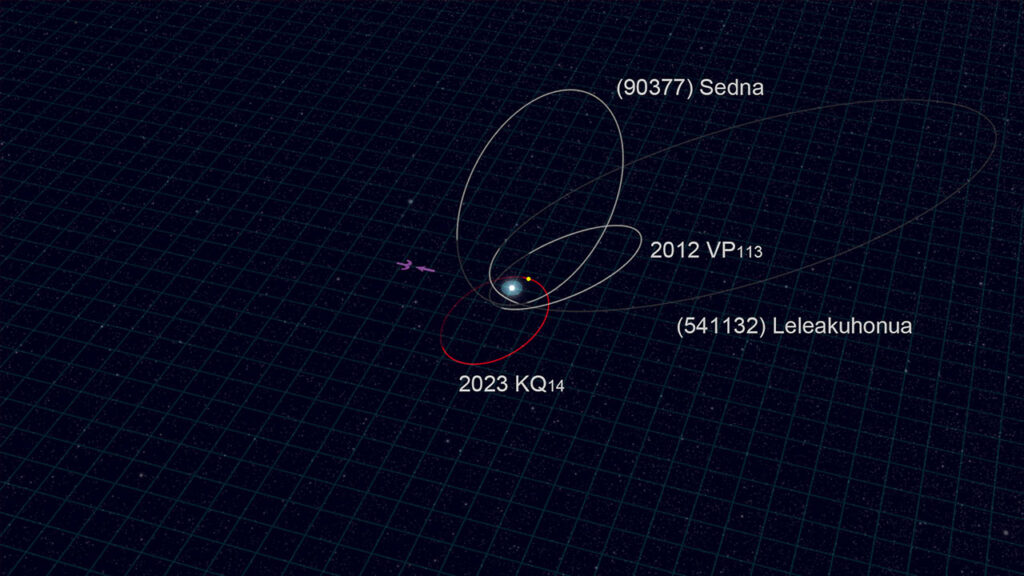
The Subaru Telescope has unveiled a groundbreaking discovery in the realm of astronomy: a small celestial body located beyond Pluto, designated as 2023 KQ 14. This discovery, announced by the National Astronomical Observatory of Japan (NAOJ), carries significant implications for our understanding of the formation, evolution, and current structure of the outer Solar System.
Discovered near its perihelion at a distance of 71 astronomical units from the Sun, 2023 KQ 14 was spotted as part of the FOSSIL survey project—Formation of the Outer Solar System: An Icy Legacy. The Subaru Telescope’s wide field of view facilitated this discovery through observations conducted in March, May, and August 2023. Subsequent follow-up observations with the Canada-France-Hawaii Telescope, along with archival data analysis, enabled astronomers to track its orbit over the past 19 years.
The Significance of a Sednoid
The object 2023 KQ 14 has been classified as a “sednoid,” a rare type of celestial body with only three other known examples. Numerical simulations by the FOSSIL team, utilizing the computational resources of the NAOJ, suggest that this sednoid has maintained a stable orbit for at least 4.5 billion years. While its current orbit diverges from those of its sednoid counterparts, simulations indicate a striking similarity in their orbits approximately 4.2 billion years ago.
This divergence in orbit underscores the complexity and diversity of the outer Solar System, challenging previous assumptions. Notably, this discovery places new constraints on the hypothetical Planet Nine, suggesting that if it exists, its orbit must be farther out than previously predicted.
Expert Insights and Implications
Dr. Yukun Huang of the NAOJ, who conducted simulations of the orbit, remarked,
“The fact that 2023 KQ 14’s current orbit does not align with those of the other three sednoids lowers the likelihood of the Planet Nine hypothesis. It is possible that a planet once existed in the Solar System but was later ejected, causing the unusual orbits we see today.”
Dr. Fumi Yoshida, another key researcher, emphasized the importance of this discovery, stating,
“2023 KQ 14 was found in a region far away where Neptune’s gravity has little influence. The presence of objects with elongated orbits and large perihelion distances in this area implies that something extraordinary occurred during the ancient era when 2023 KQ 14 formed. Understanding the orbital evolution and physical properties of these unique, distant objects is crucial for comprehending the full history of the Solar System.”
Historical Context and Future Prospects
The discovery of 2023 KQ 14 is reminiscent of earlier breakthroughs that have reshaped our understanding of the Solar System’s periphery. Similar to the discovery of Sedna in 2003, which first introduced the concept of sednoids, this finding challenges existing models and prompts a reevaluation of the dynamics at play in the outer reaches of our cosmic neighborhood.
The Subaru Telescope, with its advanced capabilities, remains one of the few instruments on Earth capable of making such discoveries. Dr. Yoshida expressed optimism about future findings, hoping that the FOSSIL team will continue to uncover more such objects, thereby enhancing our understanding of the Solar System’s history.
Collaborative Efforts and Further Research
The discovery was a collaborative effort involving several institutions, including the NAOJ, the Institute of Astronomy and Astrophysics at Academia Sinica, and Kindai University, among others. The research team, led by Ying-Tung Chen, has published their findings in the journal Nature Astronomy, providing a comprehensive analysis of the dynamics of this sednoid.
Looking ahead, astronomers plan to conduct further observations and simulations to refine their understanding of 2023 KQ 14’s orbit and its implications for the broader Solar System. These efforts will be crucial in piecing together the complex puzzle of our cosmic history.
As the search for Planet Nine and other distant objects continues, discoveries like 2023 KQ 14 serve as a reminder of the mysteries that still lie beyond the familiar planets, urging scientists to explore the unknown realms of our Solar System.






